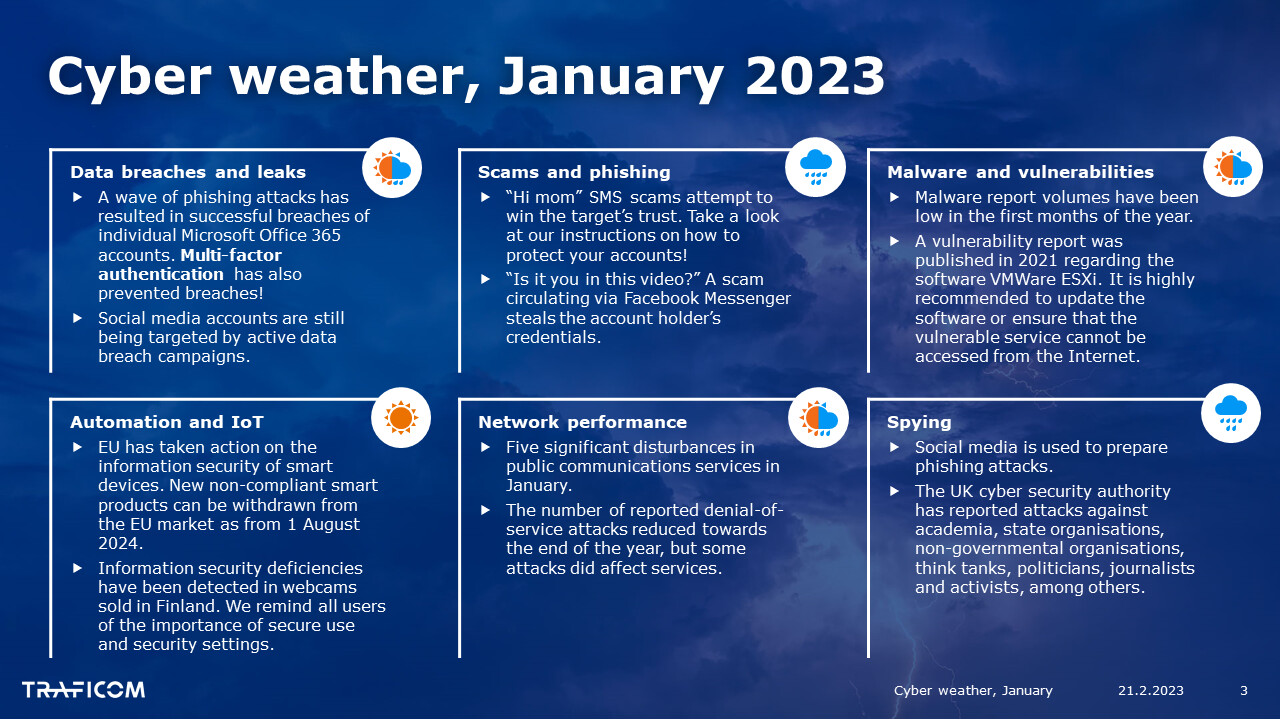Information security now!
The cyber weather reports were revamped for 2023. In addition to an updated look, some of the contents are also new. The report is targeted at organisations. The objective of our cyber weather publications is to report on cyber events in a concise and easy-to-understand form. Cyber weather supplements our Weekly review and summarises the key events of each month.

Cyber weather begins with key events of the month
Cyber weather presents a concise summary of monitored phenomena, which have already been discussed in more detail in our Weekly reviews to disseminate information as quickly as possible. The weather report begins with a six-cell table summarising the events of the month. Alerts issued during the month and other major events, such as matters promoted by the NCSC-FI, have been compiled in a new section. The page with an overview of cyber weather gives a short overall description of the month. Our aim with the cyber weather reform has been to keep the contents similar to earlier reports but increase the use of graphs and illustrative sections, without compromising accessibility.
Trends in sectors and phenomena describe wider developments
This section looks at developments and trends in different phenomena. The objective is to explain developments by providing information about their background and context. After the first quarter, the section will look at cyber security trends in different sectors and present key observations from the point of view of organisations, in particular. The graphs and statistics included in the cyber weather are published with intervals of 3–6 months and are always presented in the cyber weather report of the month when their updates are released. After that, they are no longer included in following weather reports.
One of the new graphs included is an overview of cyber weather trends over the past 12 months. The graph shows readers at a glance how the situations of different cyber security phenomena have changed.
Short- and long-term cyber weather forecasts look ahead and support foresight
The section presents cyber security phenomena in the long term (5+ years) and in the near future (6 months to 2 years). We monitor long-term cyber phenomena whose developments are widely connected to our society and may have long-term effects on several sectors and the daily lives of people. Occasionally, changes in society may also affect cyber security and we need to examine the phenomena and their effects from the opposite direction. TOP 5 cyber threats, on the other hand, highlight threats in the near future from the viewpoint of organisations, in particular.
Both long-term cyber phenomena and TOP 5 threats are based on the regular analyses of our teams of experts. The phenomena may cover a wide range of matters from international politics to technical issues. The cyber world is full of phenomena and events that affect the daily operations of various organisations. Our presentations of TOP 5 threats and long-term cyber phenomena have limited space and cannot cover all possible cases. Therefore, the threats included in our cyber weather reports are those that our experts have prioritised as the most significant ones. However, the lists are by no means intended to represent the only threats that organisations should consider in their operations. The TOP 5 threats are reviewed four times a year. The long-term phenomena are updated once a year, and one phenomenon is examined in more detail each month.
In the section on developments, regulation and standards in the information security sector, we provide information on key reforms and changes in national and EU regulation, for example. Regulatory changes, in particular, affect organisations and consumers alike.